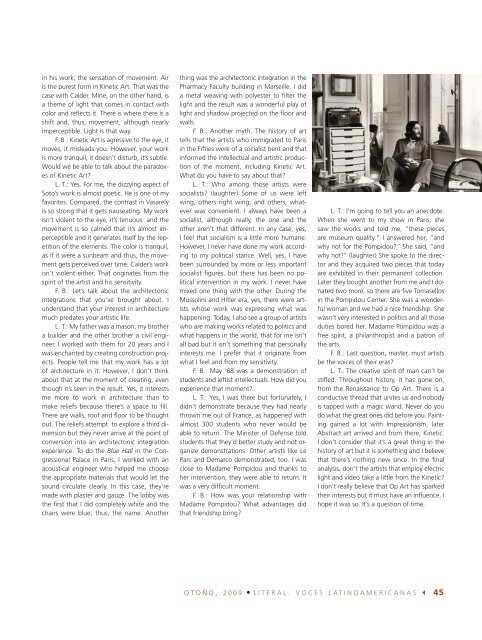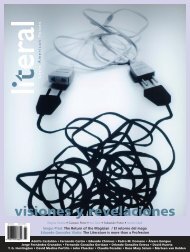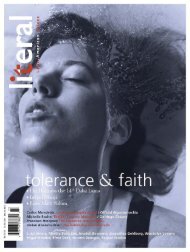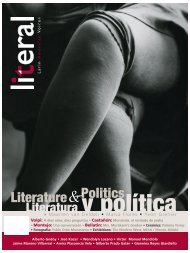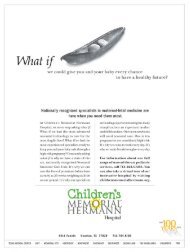Giobany Arévalo > Gabriela Torres Olivares >Anuar Jalife - Literal
Giobany Arévalo > Gabriela Torres Olivares >Anuar Jalife - Literal
Giobany Arévalo > Gabriela Torres Olivares >Anuar Jalife - Literal
You also want an ePaper? Increase the reach of your titles
YUMPU automatically turns print PDFs into web optimized ePapers that Google loves.
in his work; the sensation of movement. Air<br />
is the purest form in Kinetic Art. That was the<br />
case with Calder. Mine, on the other hand, is<br />
a theme of light that comes in contact with<br />
color and refl ects it. There is where there is a<br />
shift and, thus, movement, although nearly<br />
imperceptible. Light is that way.<br />
F. B.: Kinetic Art is agressive to the eye, it<br />
moves, it misleads you. However, your work<br />
is more tranquil, it doesn’t disturb, it’s subtle.<br />
Would we be able to talk about the paradoxes<br />
of Kinetic Art?<br />
L. T.: Yes. For me, the dizzying aspect of<br />
Soto’s work is almost poetic. He is one of my<br />
favorites. Compared, the contrast in Vasarely<br />
is so strong that it gets nauseating. My work<br />
isn’t violent to the eye, it’s tenuous and the<br />
movement is so calmed that it’s almost imperceptible<br />
and it generates itself by the repetition<br />
of the elements. The color is tranquil,<br />
as if it were a sunbeam and thus, the movement<br />
gets perceived over time. Calder’s work<br />
isn’t violent either. That originates from the<br />
spirit of the artist and his sensitivity.<br />
F. B.: Let’s talk about the architectonic<br />
integrations that you’ve brought about. I<br />
understand that your interest in architecture<br />
much predates your artistic life.<br />
L. T.: My father was a mason, my brother<br />
a builder and the other brother a civil engineer.<br />
I worked with them for 20 years and I<br />
was enchanted by creating construction projects.<br />
People tell me that my work has a lot<br />
of architecture in it. However, I don’t think<br />
about that at the moment of creating, even<br />
though it’s seen in the result. Yes, it interests<br />
me more to work in architecture than to<br />
make reliefs because there’s a space to fi ll.<br />
There are walls, roof and fl oor to be thought<br />
out. The reliefs attempt to explore a third dimension<br />
but they never arrive at the point of<br />
conversion into an architectonic integration<br />
experience. To do the Blue Hall in the Congressional<br />
Palace in Paris, I worked with an<br />
acoustical engineer who helped me choose<br />
the appropriate materials that would let the<br />
sound circulate clearly. In this case, they’re<br />
made with plaster and gauze. The lobby was<br />
the fi rst that I did completely white and the<br />
chairs were blue, thus, the name. Another<br />
thing was the architectonic integration in the<br />
Pharmacy Faculty building in Marseille. I did<br />
a metal weaving with polyester to fi lter the<br />
light and the result was a wonderful play of<br />
light and shadow projected on the fl oor and<br />
walls.<br />
F. B.: Another myth. The history of art<br />
tells that the artists who immigrated to Paris<br />
in the Fifties were of a socialist bent and that<br />
informed the intellectual and artistic production<br />
of the moment, including Kinetic Art.<br />
What do you have to say about that?<br />
L. T.: Who among those artists were<br />
socialists? (laughter) Some of us were left<br />
wing, others right wing, and others, whatever<br />
was convenient. I always have been a<br />
socialist, although really, the one and the<br />
other aren’t that different. In any case, yes,<br />
I feel that socialism is a little more humane.<br />
However, I never have done my work according<br />
to my political stance. Well, yes, I have<br />
been surrounded by more or less important<br />
socialist fi gures, but there has been no political<br />
intervention in my work. I never have<br />
mixed one thing with the other. During the<br />
Mussolini and Hitler era, yes, there were artists<br />
whose work was expressing what was<br />
happening. Today, I also see a group of artists<br />
who are making works related to politics and<br />
what happens in the world; that for me isn’t<br />
all bad but it isn’t something that personally<br />
interests me. I prefer that it originate from<br />
what I feel and from my sensitivity.<br />
F. B.: May ’68 was a demonstration of<br />
students and leftist intellectuals. How did you<br />
experience that moment?<br />
L. T.: Yes, I was there but fortunately, I<br />
didn’t demonstrate because they had nearly<br />
thrown me out of France, as happened with<br />
almost 300 students who never would be<br />
able to return. The Minister of Defense told<br />
students that they’d better study and not organize<br />
demonstrations. Other artists like Le<br />
Parc and Demarco demonstrated, too. I was<br />
close to Madame Pompidou and thanks to<br />
her intervention, they were able to return. It<br />
was a very diffi cult moment.<br />
F. B.: How was your relationship with<br />
Madame Pompidou? What advantages did<br />
that friendship bring?<br />
L. T.: I’m going to tell you an anecdote.<br />
When she went to my show in Paris, she<br />
saw the works and told me, “these pieces<br />
are museum quality.” I answered her, “and<br />
why not for the Pompidou?” She said, “and<br />
why not!” (laughter) She spoke to the director<br />
and they acquired two pieces that today<br />
are exhibited in their permanent collection.<br />
Later they bought another from me and I donated<br />
two more, so there are fi ve Tomasellos<br />
in the Pompidou Center. She was a wonderful<br />
woman and we had a nice friendship. She<br />
wasn’t very interested in politics and all those<br />
duties bored her. Madame Pompidou was a<br />
free spirit, a philanthropist and a patron of<br />
the arts.<br />
F. B.: Last question, master, must artists<br />
be the voices of their eras?<br />
L. T.: The creative spirit of man can’t be<br />
stifl ed. Throughout history, it has gone on,<br />
from the Renaissance to Op Art. There is a<br />
conductive thread that unites us and nobody<br />
is tapped with a magic wand. Never do you<br />
do what the great ones did before you. Painting<br />
gained a lot with Impressionism, later<br />
Abstract art arrived and from there, Kinetic.<br />
I don’t consider that it’s a great thing in the<br />
history of art but it is something and I believe<br />
that there’s nothing new since. In the fi nal<br />
analysis, don’t the artists that employ electric<br />
light and video take a little from the Kinetic?<br />
I don’t really believe that Op Art has sparked<br />
their interests but it must have an infl uence. I<br />
hope it was so. It’s a question of time.<br />
OTOÑO, 2009 LITERAL. VOCES LATINOAMERICANAS 45


